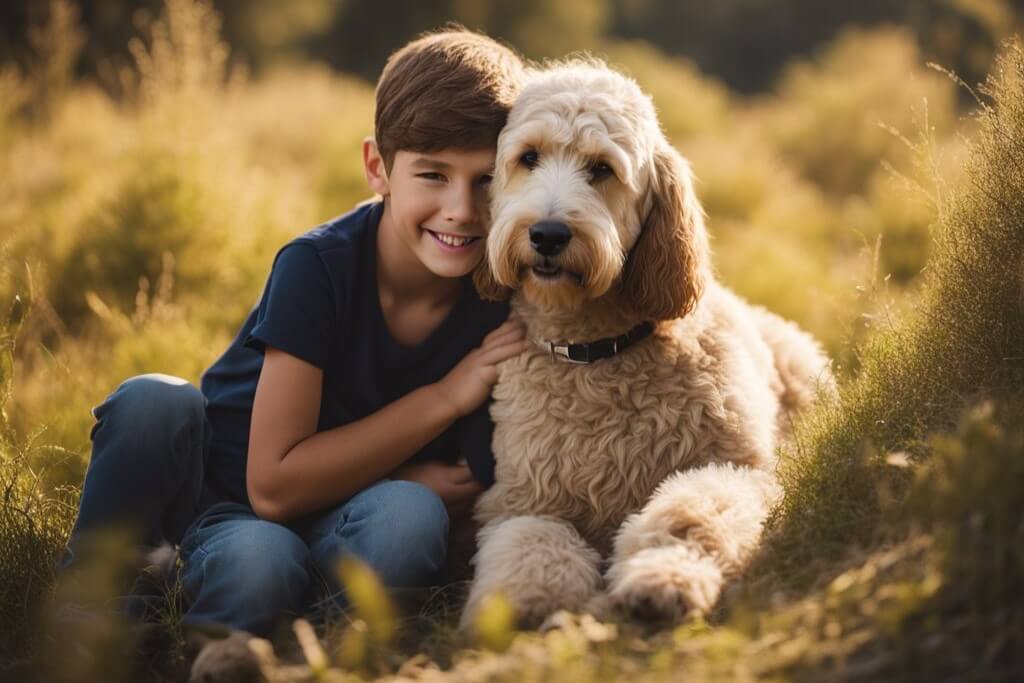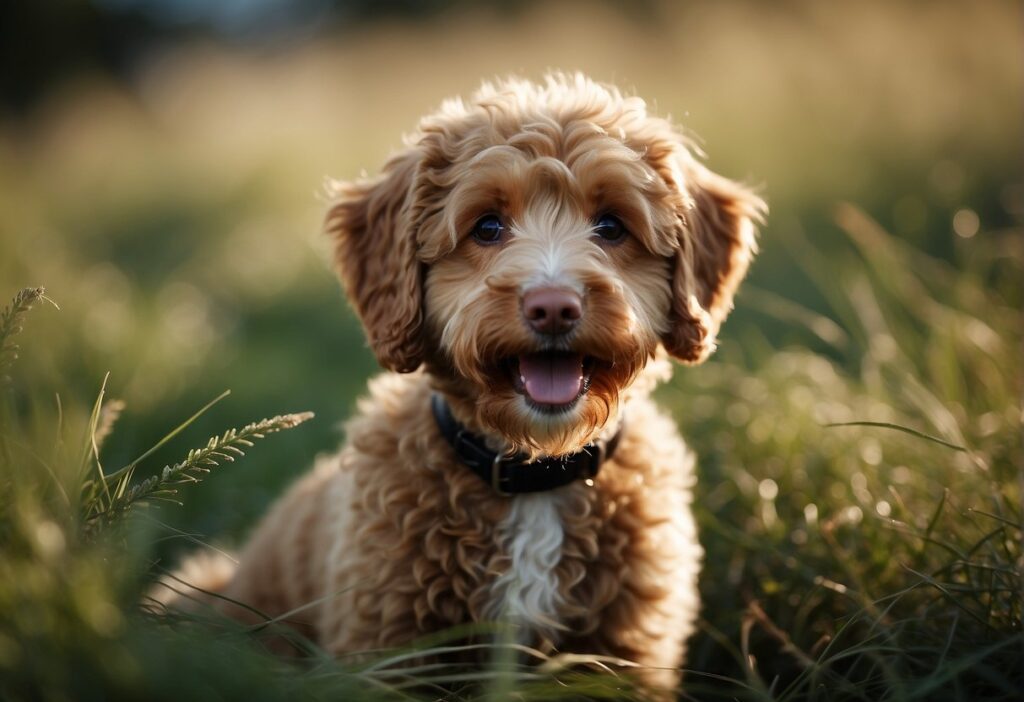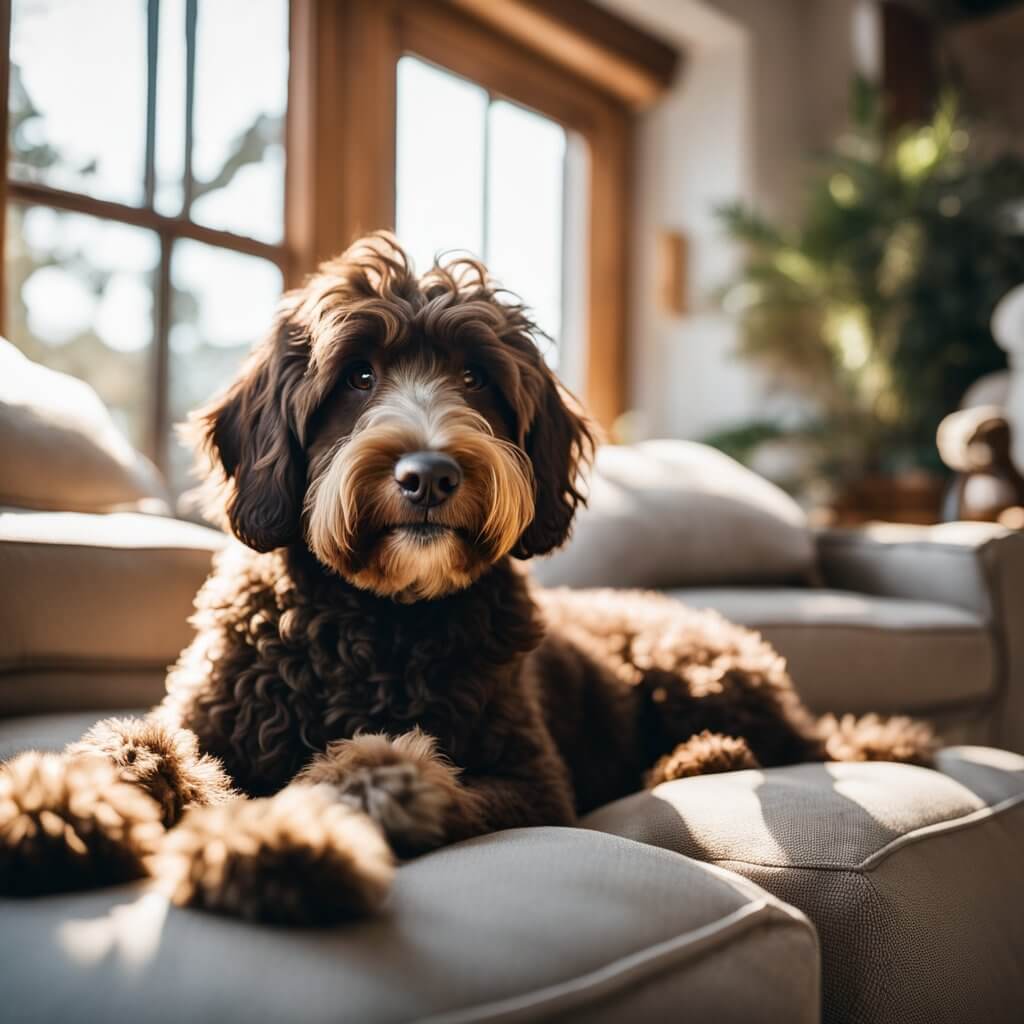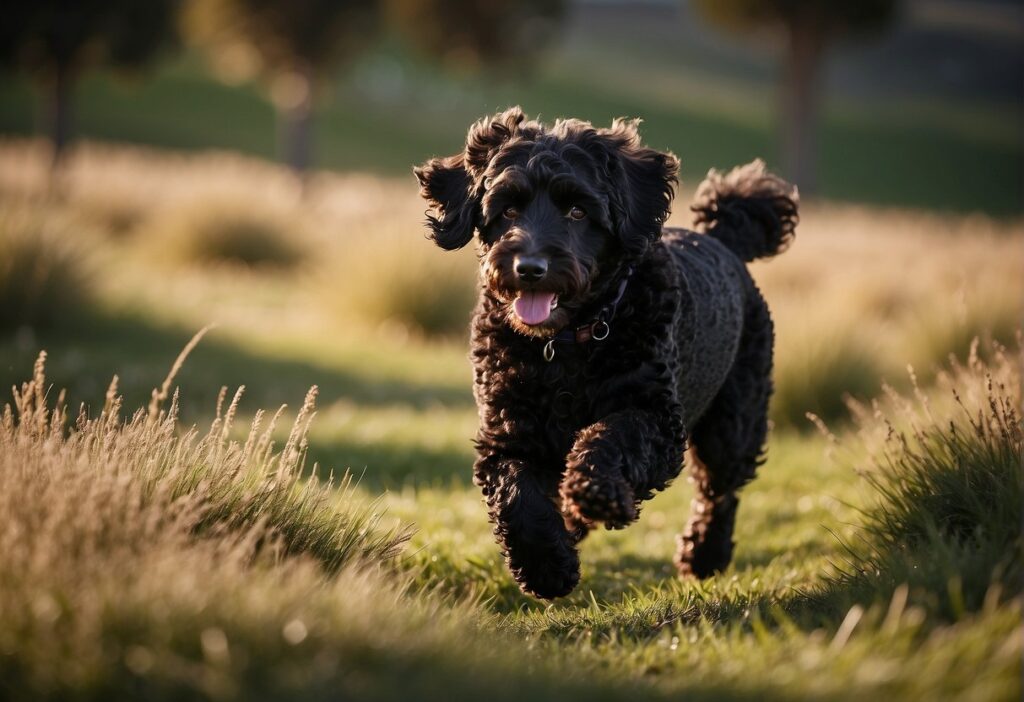Australian Labradoodle – Breed, Traits & Grooming Tips 2024

The Australian Labradoodle is a charming and intelligent breed that captures the best traits of its parent lineages. Originating in Australia, the breed was first developed by combining the friendly Labrador Retriever with the intelligent and hypoallergenic Poodle and later infused with several other breeds to improve temperament, health, and coat qualities. The result is a dog that not only has a wonderfully affectionate and outgoing nature but also tends to be less problematic for allergy sufferers thanks to its unique coat.
While originally bred to be allergy-friendly guide dogs, the Australian Designer Dog appeal extends far beyond its original purpose. This breed is known for its sociability, intelligence, and easy trainability, making it an excellent choice for families and individuals alike.
They possess the gentle nature of the Labrador Retriever and the sharp intellect of the Poodle, combined with a genetic heritage that promotes robust health. Due to their need for regular grooming and mental stimulation, prospective owners should be prepared for the responsibility of maintaining the well-being of their Australian doodle.
- The Australian Poodle is a hybrid breed with a hypoallergenic coat and a mix of desirable traits from multiple breeds.
- This breed is celebrated for its friendly temperament, intelligence, and adaptability as a family pet or service dog.
- Maintenance of the Australian Companion Dog includes regular grooming and mental stimulation to ensure its health and happiness.
Quick Look at Australian Labradoodle Traits
Height:
21 – 24 inches
Weight:
30 – 45 pounds
Lifespan:
13 – 15 years
Colors:
Chocolate, black, red, apricot, cream, and silver,
Suitable for:
Small apartments or houses and families with children.
Temperament:
Affectionate, Intelligent, Social, Energetic, and Adaptable.
History and Origin Of Australian Labradoodle

The Aussie Labradoodle is not just a simple crossbreed but a carefully developed breed with specific traits and characteristics. Your understanding of its history begins with the deliberate crossbreeding efforts aimed at creating an allergy-friendly guide dog.
Development of the Breed
The breed started in 1989 when the need for a hypoallergenic guide dog arose. A cross between a Labrador Retriever, known for its stable temperament, and a Poodle, recognized for its low-shedding coat, was thought to be the solution. Wally Conron of the Royal Guide Dog Association of Australia took on the challenge, and thus, the Labradoodle came into being. This original Labradoodle was a hybrid, primarily aimed at combining favorable traits from both parent breeds.


Influential Breeds
Over time, to establish consistency in temperament, conformation, and coat, other breeds like the Cocker Spaniel, Irish Water Spaniel, and the English Cocker Spaniel were introduced into the breeding program. This intentional addition helped refine the Australian Labradoodle into a distinct breed with its own set of standards and well-rounded characteristics. Unlike the initial Labradoodle, the Australian one has a more complex lineage and careful breeding behind it.
Australian Labradoodles are known for their Breed Standard
The Australian Labra Dog has specific standards that breeders aim to achieve regarding size, coat characteristics, and color variations. These standards ensure the health, function, and appearance of the breed are maintained.

What are the various sizes available for Aussie Labradoodles?
Australian Labradoodles come in three main size classifications:
Miniature: The Mini Australian Labradoodle expected to stand 14 to 16 inches (35 to 42 cm) and weigh 15 to 30 pounds (7 to 14 kg).
Medium: The Medium Australian Labradoodle stands 17 to 20 inches (43 to 52 cm) with a weight that falls between 30 to 45 pounds (13 to 20 kg). S
Standard: The tallest, ranging from 21 to 24 inches (53 to 63 cm) and weighing 45 to 65 pounds (20 to 30 kg).

Mini Australian Labradoodle – Grooming Tips & Tricks
Black Australian Labradoodle – Diet and Nutrition 2024
Merle Australian Labradoodle Puppies – Care Guide
How their Coat Look Like
Your Australian Labradoodle’s coat is a defining feature of the breed, with a focus on being non-shedding and hypoallergenic, making the breed a popular choice for individuals with allergies.
- Fleece: Soft texture, either straight or wavy.
- Wool: Similar to a poodle’s coat; tight and curly, offering a more non-shedding experience.
Both types should be well-groomed to maintain their quality and appeal.’



What are the different color variations observed in the Australian Poodle Mix?
The palette for your Australian Labradoodle’s coat comes in various colors and patterns, ranging from solids to mixed shades:
- Solids: Chocolate, black, red, apricot, cream, and silver, among others.
- Parti: Two colors, one of which must be white, evenly distributed. The color of the coat can change as the dog ages, and this variation adds to the individual charm of each Labradoodle Puppy.












Temperament and Behavior

When you consider an Australian Puppy, you’re looking at a breed known for its affectionate nature and intelligent demeanor. These dogs are crafted to fit well within a family dynamic due to their social temperament.
What are their Common Traits?
Aussie Labradoodles exhibit a range of common traits that make them well-loved as family pets. They are known for being:
- Affectionate: Your Labradoodle will likely seek out cuddles and form strong bonds with family members.
- Intelligent: Training your Australian Labradoodle can be a joy due to their sharp intellect; they learn commands quickly.
- Social: They thrive in the company of humans and pets alike.
- Energetic: Be prepared for brisk walks and active play sessions, as they possess a lively spirit.
Are they Suitable for Families?
When it comes to fitting into family life, Australian Labradoodles are a top choice for several reasons:
- Good with Children: Their gentle nature makes them excellent companions for kids.
- Active Lifestyle Fit: If your family is active, your Labradoodle will be a willing participant in your adventures, whether it’s a hike or a game of fetch in the yard.
- Adaptable: They are versatile and can adapt to different living situations, as long as their social and exercise needs are met.

Are Australian Labradoodles Hard to Potty Train?

Are Australian Labradoodles Good Hunting Dogs?
Health and Lifespan

Australian Labradoodles are generally known for their good health and longevity, often living between 13 to 15 years. Maintaining their health includes being aware of common health issues, ensuring proper health testing, and considering factors like exercise needs and nutrition.
Are Australian Poodle Mix Prone to Diseases?
Your Australian Poodle Mix may be predisposed to certain health problems. One prevalent issue to monitor is Hip Dysplasia, an abnormal formation of the hip socket that can cause arthritis and lameness. Regular veterinary check-ups can help in early detection and management of this condition. Being informed about these potential health issues is vital for proactive care.
How to Test the Health of Your Australian Puppies?
When selecting a breeder, they must conduct thorough health testing on their breeding dogs to minimize the risk of genetic disorders being passed to puppies. Opt for breeders who provide clear evidence of health clearances. Your strategies should include regular vet check-ups, a balanced nutrition plan, and daily exercise to support your dog’s overall well-being and help prevent health issues associated with obesity and inactivity.
Aussie Labradoodles require proper Grooming and Care

Maintaining your Labradoodle Breed’s appearance and health involves regular grooming and attentive care. With a focus on their distinctive coat and nutritional needs, you’ll ensure your pet stays happy and healthy.
How you can meet their Grooming Needs?
Your Australian Puppy has a unique coat that requires consistent grooming to prevent matting and ensure cleanliness. Brushing should be done multiple times per week—perhaps even daily for those with wool or fleece coats. It’s crucial to use the right grooming tools:
- A slicker brush for detangling
- A comb for finer grooming
- Proper shampoo and conditioner
Australian Retriever Poodles are known for being low-shedding, but this doesn’t mean they are maintenance-free. Regular grooming sessions not only keep their coat in prime condition but also provide an opportunity for you to check for any skin issues or parasites.

Bathing your dog too frequently can strip their coat of natural oils, so aim to bathe them only when necessary—monthly or when particularly dirty. Always brush your Labradoodle’s coat beforehand to avoid tightening any mats.
They Need Regular Exercise and Proper Nutrition
Your dog’s health and coat condition are significantly influenced by two factors: exercise and nutrition. Adequate exercise ensures your Labradoodle maintains a healthy weight and muscle tone, which contributes to overall well-being. Structured activities, like walks or play sessions, should be a part of their daily routine.
When it comes to nutrition, providing a balanced diet is key. High-quality dog food that meets their nutritional requirements helps maintain a shiny, healthy coat and good skin health. Make sure you provide:
- A diet rich in Omega-3 fatty acids for coat health
- Enough fiber to support digestion
- Adequate protein for energy and muscle maintenance
Adjust portions based on your dog’s size, age, and activity level to avoid overfeeding. Remember that proper nutrition can also help manage shedding by fortifying the coat and skin. Visit a veterinarian for specific recommendations tailored to your Aussie Labradoodle’s needs.
Consistent grooming paired with a sound exercise and nutrition plan will keep your Poodle Labrador Hybrid looking and feeling their best.

How Often to Bathe an Australian Labradoodle?

How to Trim Australian Labradoodle Face?
Are they easy to Train and Stimulate?
Aussie Labrador Poodles, known for their intelligence and agility, are generally easy to train, but your commitment to their training and mental stimulation is crucial for their development. Their clever and often comical nature can make training both a joy and a challenge.
How to Train Them Properly?
When you begin training your Australian Labrador Cross, remember that consistency is key. An intelligent breed, they pick up commands quickly. Start with basic obedience commands such as sit, stay, come, and heel. Your Labradoodle’s agility and eagerness to please will often make these initial training sessions a rewarding experience.
Given their social nature, early socialization is vital to prevent anxiety and fear around new people or environments. Aim for short, positive training sessions; engaging in training sessions for about 10-15 minutes will keep your puppy focused and prevent them from feeling overwhelmed.
Engage them in Stimulating Games and Activities
Just as physical exercise is important, so too is mental stimulation for maintaining your Australian Doodle’s mental health. They need activities that challenge their mind to stay engaged and happy. Puzzle toys, scent games, and agility exercises not only stimulate their brains but also provide an outlet for their boundless energy.
Incorporating mentally stimulating activities such as searching exercises can keep your Labradoodle in peak mental condition. Remember, Australian Puppies thrive on engagement; neglecting their need for mental exercise can lead to behavior problems, so be mindful of incorporating these activities into their routine.
Are Aussie Labradoodle easy to Breed?
When you’re looking into Australian Labrador, understanding responsible breeding practices is crucial. It ensures the health and well-being of the puppies and maintains the integrity of the breed.
Try to Find a Reputable Breeder
Responsible breeders of Australian Poodle mix adhere to a strict Code of Ethics. They prioritize the health, temperament, and conformation of the dogs. When you set out to find a puppy, it’s important to choose a breeder who is transparent about their breeding practices and can provide health clearances for genetic conditions. Breeders should be members of recognized associations, like the Australian Labradoodle Association of America, which dedicates itself to responsible breeding.
Infusion Breeding Techniques
Infusion breeding is an approach that carefully introduces new genetic material into the Australian Hybrid Canine gene pool. This technique is used to enhance specific traits such as coat quality, temperament, and vigor while minimizing genetic health risks.
Breeders engaged in infusion breeding must have a comprehensive understanding of genetics and long-term breed development plans. Membership in breeding associations often offers access to resources and guidelines for effective infusion breeding.
Can we use Australian Labradoodles as Service Dogs?
The Aussie Labradoodle has gained a reputation as an effective service dog due to its desirable qualities such as non-shedding coats and intelligent temperament.
What are the Best Attributes of Service Dogs?
Intelligence and Temperament: For a dog to excel as a service dog, intelligence and a stable temperament are paramount. Australian Labradoodles are renowned for their quick learning ability and level-headedness. These traits are crucial as they allow for efficient training and ensure the dogs can perform tasks reliably.
Hypoallergenic Qualities: Many individuals require a service dog but suffer from allergies. Australian Labradoodles are often sought after for their hypoallergenic coats, which are less likely to trigger allergic reactions, making them a suitable option for such handlers.
Will the Labradoodle be trained for Service Roles?
Diverse Service Functions: Your Australian Labradoodle can be trained for various service roles. Given their origins involving breeds like the Labrador Retriever and the Poodle, these dogs are well-equipped to act as guide dogs for the visually impaired due to their alertness and ability to navigate obstacles.
Record in Service: The positive impact of Australian Labradoodles in service is well-documented. They have been successfully assisting individuals with their needs, whether it is providing physical support or aiding with daily tasks.
In your journey to understand or select a service dog, consider the Australian Labradoodle’s track record as a guide dog and service animal. Their intelligence, beneficial temperament, and hypoallergenic properties make them excellent companions in service roles, whether in homes or therapeutic settings.
Are Australian Poodle Puppies Good for Adoption & Rescues?
When considering an Australian Labradoodle as your family dog, adopting one from a shelter or rescue organization is a responsible choice. It helps provide a loving home to a dog in need and can be a rewarding experience for all involved.
How you can start an Adoption Process?
To adopt an Australian Labradoodle, start by researching local shelters and finding a reputable organization that specializes in the breed. The adoption process generally includes filling out an application, allowing a home visit, and sometimes attending an interview.
- Fill out an adoption application: Provide detailed information about your living situation and experience with pets.
- Attend a home visit: This allows the shelter to assess if your home is a safe environment for a dog.
- Go through an interview process: Shelters may require an interview to ensure you are prepared for a new pet.
Organizations such as Labradoodle Rescue Near Me offer tools to easily find Australian Labradoodles for adoption in the United States.
How can you assist in Supporting Shelters for Australian Doodles?
Supporting shelters is crucial for the welfare of Australian Labradoodles waiting for adoption. There are several ways to support these organizations:
- Donations: Financial contributions help cover medical expenses, food, and shelter.
- Volunteering: Offer your time to assist with the care of the dogs or administrative tasks.
- Fostering: Open your home temporarily to a Labradoodle in need, providing them with a family environment.
IDOG Rescue is an example of a foster-based non-profit dog rescue for Doodles, and they rely heavily on contributions from the community.
Why this Breed is so Popular?
The Australian Labradoodle has captivated hearts around the world. Your curiosity about this designer breed’s rise to fame and its contemporary standing is well justified by its unique characteristics and widespread appeal.
Rise in Popularity
The Australian Labradoodle experienced a significant boost in popularity as a result of its hypoallergenic coat, making it an attractive option for allergy sufferers. Originally bred in Australia, this breed was designed to combine the best traits of the Labrador Retriever and the Poodle, with influences from other breeds such as the English and American Cocker Spaniel, as well as the Curly Coated Retriever and Irish Water Spaniel. The goal was to create a dog that exhibited a consistent set of desirable traits, including a friendly demeanor and low-shedding coat.
You can see the diverse ancestry of the Australian Labradoodle contributing to its trend as not just a family pet, but also a capable service dog. These qualities, paired with the rise of ‘doodles’ in the designer breed market, have firmly established its popularity.
Do They Hold a Contemporary Status in Society?
In today’s society, the Australian Labradoodle holds a prestigious place among dog breeds. This breed is not just a trend but has developed a reputation for being intelligent, trainable, and sociable. Doodles have woven their way into the fabric of many societies, with their hypoallergenic coats being particularly beneficial for indoor environments and people with allergies.
These dogs are regularly featured on social media, increasing their visibility and desirability. As a result, they have become a stalwart in the designer breed category, with their widespread acceptance influenced by their hypoallergenic traits and versatile nature.
Helping FAQs for Pet Owners
When considering adding an Australian Labradoodle to your family, it’s essential to gather reliable information. Here are answers to some of the most commonly asked questions about this breed.
How do you find a reputable Labradoodle breeder?
To ensure you’re working with a reputable breeder, look for those who are forthcoming with information about their breeding practices and who can provide health clearances for the puppy’s parents. Breeders affiliated with organizations such as the Australian Labradoodle Association of Europe adhere to specific standards and practices.
What are common health issues in Australian Labradoodles?
Australian Poodle mix are generally healthy, but like all breeds, they can be prone to certain health conditions. These can include hip dysplasia, elbow dysplasia, and eye disorders. Make sure to inquire about the health history of the puppy’s parents and any health screenings done by the breeder.
What is the average cost of an Australian Labradoodle puppy?
The cost of an Aussie Labradoodle puppy can vary widely, typically ranging from $2,500 to $3,000, depending on the breeder’s location and reputation, the puppy’s lineage, and whether the puppy has undergone any training or genetic testing. Research breeders thoroughly to understand what is included in the price.
How big can I expect my Australian Poodle Dog to grow?
Australian Poodle Blend comes in three sizes: mini, medium, and standard. A mini Labradoodle can weigh 15 to 30 pounds, a medium can weigh 30 to 45 pounds, while a standard can weigh 45 to over 60 pounds. The size often depends on the poodle parentage within the Labradoodle’s lineage.
Are there specific grooming needs for an Australian Labradoodle?
Yes, Australian Retrieving Poodles require regular grooming due to their unique coats which can range from wavy to curly. They must be brushed several times a week to prevent matting, and it’s recommended to have them professionally groomed every 4-6 weeks. A curly-coated Labradoodle sheds the least, but all coats need attention to remain healthy.
What kind of temperament can I expect from an Australian Labradoodle?
They are known for their friendly and outgoing temperament. They are intelligent and social, making excellent family pets as they tend to get along well with both children and other animals. They require mental stimulation and enjoy being active with their human companions.









